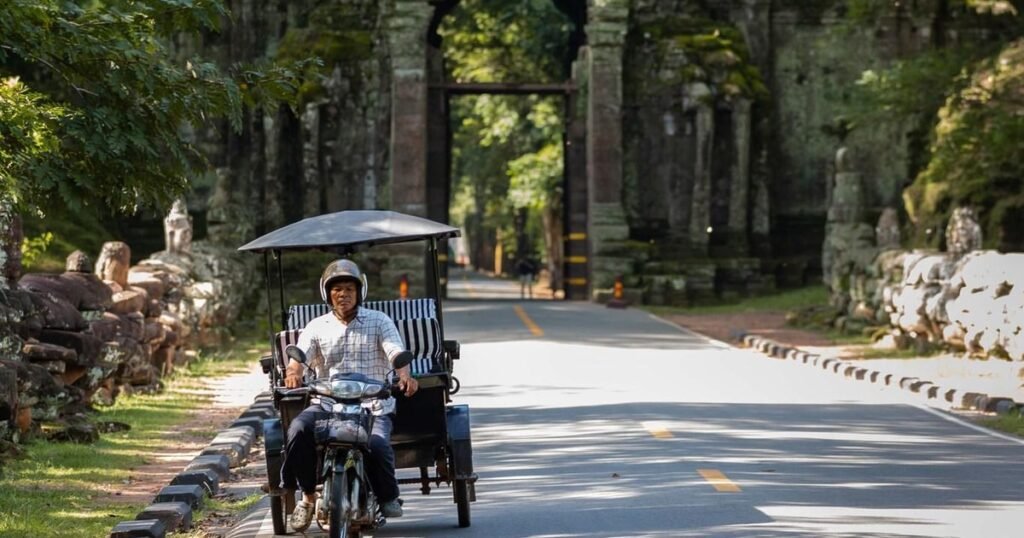West Baray Reservoir - Baray Teuk Thla

West Baray, known as Baray Teuk Thla in Khmer, translates to “Clear Water Reservoir” in English. This expansive reservoir is situated to the west of Angkor Thom, measuring 7.8 kilometers in length and 2.1 kilometers in width, making it the largest baray constructed during the ancient Angkor period. It ranks among the largest artificial reservoirs globally, boasting a maximum capacity of approximately 53 million cubic meters.
Table of Contents
ToggleAt the center of the baray lies the West Mebon temple. During the dry season, visitors can walk to the temple, whereas, in the rainy season, access is typically by boat.
West Baray serves as a favored destination for both Cambodians and tourists, offering opportunities for swimming, dining, and leisurely gatherings with friends and family.
Experience a private Tuktuk tour of Angkor Wat and its neighboring temples. Discover the grandeur of Angkor Thom, Ta Keo, Banteay Kdei, and additional locations...
Layout and Design
It is widely accepted that the West Baray was constructed due to the inadequacy of the East Baray in meeting the needs of the rapidly growing Angkor empire. This baray functioned as a substantial reservoir for water, which was utilized during arid seasons. Such a system enabled farmers to cultivate multiple rice harvests annually. Additionally, it is thought that the West Baray holds symbolic significance, representing the Sea of Creation in Hindu mythology.
In contemporary times, a large lock has been installed on the southern side, which is visible upon arrival. This structure facilitates the irrigation of agricultural fields located to the south of the baray. Furthermore, the site has evolved into a popular destination, offering swimming, local cuisine, and hammocks that draw numerous visitors.
History of West Baray
The construction of West Baray commenced under the reign of King Suryavarman I in the 11th century and was finalized during the rule of Udayadityvarman II. The development of this extensive reservoir led to the destruction or submersion of previously established sites. The adjacent Ak Yum temple was partially inundated, leaving only remnants visible today.
Archaeological investigations in the vicinity have uncovered an inscription stele that dates back to 713 AD, indicating the presence of a significant settlement in the area, which was largely obliterated during the construction of West Baray.
Conversely, it appears that West Baray integrated elements of earlier structures. Portions of King Yasovarman’s capital city, with Phnom Bakheng as its focal point, were utilized in the creation of the eastern dike.
West Mebon also holds historical importance, having yielded a large bronze statue of Vishnu. Although this statue is no longer located in the area, it is preserved at the National Museum in Phnom Penh.
Should Visit or Not
West Baray is a favored destination for both tourists and locals alike. It tends to be especially crowded during weekends and holidays. Visitors have the option to rent rubber rings for swimming in the baray, or they may choose to relax in a hammock while enjoying refreshments by the water. Additionally, boat rides are available for those wishing to explore the West Mebon temple.
For those seeking a more adventurous experience, it is possible to traverse the entire reservoir. The southern route is relatively well-maintained, allowing passage past the Ak Yum temple and towards the southwestern area. However, as one continues along the western and northern sides of the Baray, the road conditions deteriorate significantly, eventually becoming nearly impassable. Despite this, bicycles and motorcycles can navigate the area year-round, although traveling by car is not recommended.
Location & How to Get West Baray
West Baray is located approximately 12 kilometers from Siem Reap town and is easily accessible. While many visitors opt for a tuk-tuk, cycling is also an option for those comfortable navigating a main road.
To arrive at West Baray, depart from Siem Reap via National Road 6, which leads towards the airport. Continue straight through the airport roundabout and proceed for an additional 3 to 4 kilometers. At this point, make a right turn and follow the road until it concludes.
Upon reaching West Baray, you will encounter a steep incline. If you are traveling by tuk-tuk, you will need to disembark and ascend the hill on foot.

